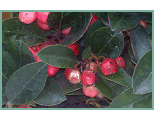wintergreen

WINTERGREEN. An aromatic, creeping evergreen (Gaultheria procumbens), having bright red berries; – called also aromatic winter-green, checkerberry, and partridge-berry. The name is also applied to several species of plants of the heath family. — Webster, 1882
 Nothing else was ever so good as wintergreen berries dug out of the snow. – Farmer Boy, Chapter 10, “The Turn of the Year”
Nothing else was ever so good as wintergreen berries dug out of the snow. – Farmer Boy, Chapter 10, “The Turn of the Year”
 Almanzo’s wintergreen (Gaultheria procumbens), or checkerberry, is a native of Canada and the Allegheny mountains, named in honor of Dr. Gaulthier, a Canadian physician and botanist. The dwarf evergreen shrub spreads when undisturbed, and bears both ripe fruit and flowers at the same time. The plant has one or more reddish stems, a few inches in height; flowers are white, ovate, and five-toothed. Plants may reach 6 inches in height. Plants bloom May – September and mature to produce berries about 1/3 of an inch wide.
Almanzo’s wintergreen (Gaultheria procumbens), or checkerberry, is a native of Canada and the Allegheny mountains, named in honor of Dr. Gaulthier, a Canadian physician and botanist. The dwarf evergreen shrub spreads when undisturbed, and bears both ripe fruit and flowers at the same time. The plant has one or more reddish stems, a few inches in height; flowers are white, ovate, and five-toothed. Plants may reach 6 inches in height. Plants bloom May – September and mature to produce berries about 1/3 of an inch wide.
The checkerberry is a peculiarly American plant, well known by its pleasant aromatic flavor, its shining evergreen leaves, its delicate white flowers, and its scarlet berries. There are no wild fruits so attractive to young persons, from the time they begin to redden in the autumn, and all through the winter, when the ground is open, until they are seen hanging on the vine with the blossoms of spring. Indeed, this fruit is not perfected until it has remained on the bush during the winter. The severest cold has no effect upon it; and the berries increase in size, after the spring opens, until they become as large as strawberries.
The plant is abundant in all woods in New England, and seems to be confined to no particular soil or situation. Indeed, I doubt whether another woody plant can be found so generally distributed throughout the New England forest. If it has any preferences, they seem to be the lower slopes of wooded hills and mountains. But I have seen it in all locations where it can enjoy the protection of trees, in evergreen as well as deciduous woods; for though the leaves of the pine prevent the growth of any considerable underwood, the checkerberry is always abundant in the openings of a pine forest. — Wilson Flag, A Year Among the Trees: Or, The Woods and By-ways of New England (Boston: Educational Publishing Company), 1881.
 The Yale Literary Magazine for June 1864 (page 292) reported that “the proper place to spend a spring vacation was up in the New York country-side, where they have trout springs, and wintergreen berries, and birds, and wild-flowers.”
The Yale Literary Magazine for June 1864 (page 292) reported that “the proper place to spend a spring vacation was up in the New York country-side, where they have trout springs, and wintergreen berries, and birds, and wild-flowers.”
 Wintergreen flavoring. The leaves of the wintergreen plant contain a very stimulant volatile oil (oleum garltheriæ), which is colorless when first distilled but gradually becomes reddish. An infusion of the leaves in alcohol – Mrs. Wilder’s wintergreen leaves in whiskey – was very popular for use as both flavoring in both food items and medicines. The oil contains methyl salicylate, a close relative of aspirin, so wintergreen oil and wintergreen berries were used to treat headaches, pain, inflammation, rheumatism, and colic. Oil of wintergreen imported from Europe was often used in perfumes. A similar oil is obtained from the bark of the sweet birch, Betula lenta.
Wintergreen flavoring. The leaves of the wintergreen plant contain a very stimulant volatile oil (oleum garltheriæ), which is colorless when first distilled but gradually becomes reddish. An infusion of the leaves in alcohol – Mrs. Wilder’s wintergreen leaves in whiskey – was very popular for use as both flavoring in both food items and medicines. The oil contains methyl salicylate, a close relative of aspirin, so wintergreen oil and wintergreen berries were used to treat headaches, pain, inflammation, rheumatism, and colic. Oil of wintergreen imported from Europe was often used in perfumes. A similar oil is obtained from the bark of the sweet birch, Betula lenta.
An early recipe for wintergreen creams reads: Take two cups granulated sugar, one-half cup cold water. Mix and boil hard for three minutes. Remove from heat and add two teaspoons wintergreen oil. Beat hard until white and creamy and drop very quickly in pats on greased paper. — Frances Owens, Mrs. Owens’ New Cook Book and Complete Household Manual (Chicago: Owens’ Publishing Company, 1899), 679.

wintergreen (FB 10)
berries (FB 10)
flavoring (FB 10), see also custard / ice-cream
twigs (FB 15)

